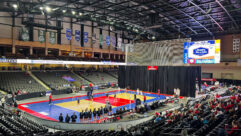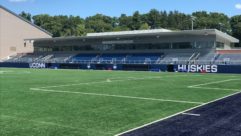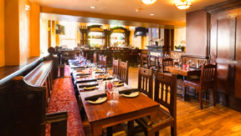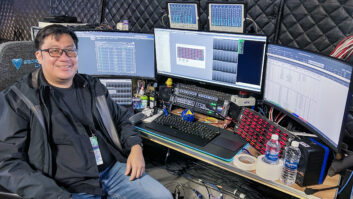Sound design takes Center Ice
Nov 1, 1997 12:00 PM,
Sam Gidren
Located in Tampa, the Ice Palace is the frozen play ground of the NHL’sTampa Bay Lightning, an expansion team that took to the ice in this brandnew facility at the end of September. Built in the classic oval-shapedfashion, which lends itself so adroitly to sporting arenas of this nature,the venue seats around 20,000 fans. The brainchild of the Kansas City-basedarchitectural firm of Ellerbe and Becket, the arena relies upon an audiosystem design which sprang from the fertile imagination of Brad Ricks atWJHW in Dallas. Featuring six distributed loudspeaker clusters made up (seepage 34) entirely of Community components, the system is fueled by aNexSys-controlled army of Crest amplifiers, and it is processed entirelywithin the digital domain by three of TOA’s DACsys II DP-0204 units.
A member of WJHW’s stable of wunderkind designers, Brad Ricks is probablybest known for his designs for north-of-the-border forums such as RaptorsStadium in Toronto and the Edmonton Coliseum. Among the more recentprojects are the new Redskins Stadium and the Denver Arena.
“Tampa’s Ice Palace audio system was designed expressly for a hockeyvenue,” Ricks said. “And it would work well for basketball too if the needarose in the future. One of the biggest advantages of this six-clusterdistributed system for hockey is that it improves speech intelligibilityand clarity by moving the loudspeakers closer to the audience. The shadowzones you might develop in the first few rows of seats with a centralcluster are absent as well because the loudspeaker arrays are positionedout over the dasher-boards. The sight lines remain clean too.”
Used for music and announcements, the system is full-range, operatingbetween 50 Hz and 18 kHz. Two of the six loudspeaker clusters are flown atthe ovoid ends of the arena; the other four reside in equally spaced arraysof two along each of the flat sides of the structure. The four sideclusters are each divided into four distinct tiers of components. Each tierreceives a specially processed signal from one of the three digital signalprocessors according to the needs of 11 audio zones in the arenaestablished by Ricks.
The top row in the side clusters comprises a pair of Community’s RS660enclosures. Directly underneath in the next tier lies a pair of RS220s.Descending tiers house another pair of RS220s and a pair of low-frequencyCBS315s respectively. Notably larger to compensate for the wider areas ofcoverage they serve, the end clusters are split into five tiers ofcomponents. A pair of RS660s starts things out in the top row, followed inthe second by a single RS660. The next two levels have three RS220s apiece,and the bottom is the low-frequency stratum with four CBS315s. As with theside clusters, each level of the end cluster receives its unique processingfrom the DACsys II units.
For fill coverage down on the ice, four of Community’s horizontallyconfigured RS220H loudspeakers were suspended from the centrally locatedscoreboard at a ratio of two per side.
The RS series components throughout the clusters can be used withproprietary electronic controllers available from Community, Ricks chose togo with his own processing, given the complexity of the zoning on the joband his unique processing needs. As he configured the arrays, the designrelied upon a true four-way split of the signals with the bottom- dwellingCBS315s crossing into the modular three-way RS660s and RS220s at around 250Hz.
“The Community components we selected offered the highest amount ofperformance per dollar in this application,” Ricks notes. “While the RS660sand RS220s delivered the projection, pattern control and intelligibility wewere seeking, plus the extended high-frequency response of their VHF 100drivers, the CBS315s provided solid, low-end efficiency. I have to admitI’m somewhat partial to the latter especially, as I’ve used them at RaptorsStadium with great success, and I plan to use them again for RedskinsStadium and the Denver Arena too.”
The arena system’s Crest power comes on strong from a NexSys- controlledgalaxy revolving around seven 2,050 W 9001s and 17 CKS series amps rangingfrom a 900 W CKS1200-2 to 13,600 W CKS800s. (All preceding power ratingsare based upon a 4 V load.) Crest power fuels the Ice Palace’s 70 Vancillary systems as well with CKV series product.
Given the remote control capabilities of the computer-based NexSys system,the power amps are located along catwalks up close to the arrays to savethe labor and expense of running long loudspeaker lines from the systemcontrol room far below. Most of the system’s signal processing is alsolocated with the amps, which reside in eight Middle Atlantic wrk-44 racks.
Only one signal travels from the downstairs control room to the catwalk.Once it arrives, it enters a bridging transformer, exits and is greeted byan Oxmoor MDA-16 distribution amp. Eleven signals emerge on the other sideof the DA, and they are instantly placed in digital custody within theDACsys II units. Ricks then treats the signals with delay, crossover andlimiting for system protection in appropriate amounts for each of hisseparate clusters and the tiers of individual components within.
“The DACsys II processors afford a lot of flexibility in this system,”Ricks points out. “We can bandpass, delay and EQ each signal independentlyaccording to the specific needs of the 11 audio zones. Plus, we can createpresets for different system configurations and store them for the timeswhen the system is used as supplemental reinforcement for a concert and soforth.”
Back downstairs in the control room, system operators ride herd over theincoming signals from behind a 24 x 3 DDA CS3-24 console. Outboard gearinstalled at the house mix position is kept comfy in an eight-space Slim-5rack enclosure from Middle Atlantic. Besides the spoken word, sourcematerial is also supplied by a Tascam 112R-MKII cassette deck and a TascamCD-301 CD player with remote control.
The ancillary Crest-powered 70 V systems reinforcing areas throughout thearena, such as press lounges, concession stands, suites, and the ticketcounters, required a tremendous amount of routing, equalization, limitingand all the other normal audio necessities. Managing all of these taskssimultaneously is a MediaMatrix system from Peavey. Custom control screensfor the device allow system operators to do virtual routing of any signalto any area with ease.
The contractor on the project was Professional Sound Services of Tampa. Theoriginal plans for the system were drawn in 1991, but various delays keptthe project on hold until Ricks picked up the pieces in the summer of 1995.Given technological advances made since the first plan saw light, Rickseffectively canned all of the elements of the original design and startedanew.
“Sound quality was my first and primary concern,” he says of the designprocess that led to the Ice Palace sound system’s completion just in timefor the Tampa Bay Lightning’s opening game in late September of this year.”Operationally, I wanted to create a cutting edge system that was easy foroperators to use effectively as well. This, as well as for maintenancereasons, is why I chose computer control. Overall, I wanted to keep thesystem straightforward and cost-effective while still offering performanceon par with any other venue of this type. If a satisfied client and fansare indicative of anything, based on available evidence, I’d say we’ve donequite well.”
The Community CBS315 is a high-output, high-power, low frequency systemexpressly designed for long-throw applications in the newer jumbo-sizedarenas, stadiums and other large-scale facilities.
Mathematically correct horn loading for the drivers focuses the system’soutput in a tight 60 degrees x 60 degrees pattern over the upper part ofits bandwidth with the pattern smoothly widening at the lower frequenciesto maximize efficiency throughout the operating range. The CBS315 isspecifically designed for arraying, which effectively increases the patterncontrol and, through mutual coupling, the efficiency at lower frequencies.
The CBS315 uses three triple-spider, high-sensitivity 15-inch (38 cm)drivers with heavy-duty motor structures. The triple-spider suspensionmaintains secure control over the voice coil centering even at extremedrive levels. In addition it provides superior damping for the cone,preventing bass overhang and enhancing the transient response of thesystem. High stiffness- to-mass ratio cones and high-linearity, long-throwsuspensions ensure low distortion at high drive levels. All drivers aredesigned by Community.
The CBS315’s trapezoidal enclosure is made from high-quality 13-ply Balticbirch. Internal bracing helps eliminate cabinet resonances and flexing athigh output levels that would otherwise induce distortion and compromiseefficiency. The one-piece integral fiberglass horn baffle provides astrong, non-resonant structural mounting as well as optimum horn loadingfor each driver. The enclosure incorporates a removable side panel foraccess to the drivers for testing or repair.
The CBS315 is designed as an optimum low-frequency complement to theCBA6060 full-range system in terms of its output level, pattern control,frequency range and physical dimensions.










